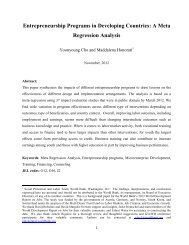Download - Youth Economic Opportunities
Download - Youth Economic Opportunities
Download - Youth Economic Opportunities
Create successful ePaper yourself
Turn your PDF publications into a flip-book with our unique Google optimized e-Paper software.
Who Teaches Us Most About Financial Programing in Africa<br />
How to deal with competitors that had developed more sophisticated measuring<br />
and packing techniques<br />
Livestock disease<br />
These inherent risks created barriers to entrepreneurship among this group.<br />
The risks were beyond their control and put the business ideas beyond their reach,<br />
as the young women maintained the fragile balance between incoming resources<br />
and necessities. Within this context, a low-risk business delivering low profits<br />
immediately would always trump a move into a higher-risk business offering far<br />
greater profits but with a longer payback period, unless the risk could be mitigated<br />
through a business training program with a new financing model.<br />
The women showed a high level of empathy with their peers, something that<br />
was apparent throughout the three-year training of 434 young women. Their inclination<br />
was to help and support each other, so the concept of competing with each<br />
other for market share in a new business was a significant barrier. However, the<br />
existing marketplace, which was highly competitive across a narrow range of businesses,<br />
such as hairdressing, selling second-hand clothes, and food stalls, was seen<br />
as an acceptable environment in which to compete. The result was an undiversified<br />
business environment in which innovation took place in a small range of<br />
enterprises. Goods and services that were not available within the rural environment<br />
continued to be purchased in town, thus depleting the rural economy.<br />
CASE STUDY: THE MPIKA PRESCHOOL<br />
The 10,000 Women Initiative encouraged both social and business enterprises. The<br />
participants were already fully engaged as community activists, giving their time to<br />
support particularly vulnerable members of their communities. They spoke at<br />
schools, for example, encouraging pupils to study and succeed. They cleaned the<br />
homes of women in the advanced stages of HIV/AIDS. They counseled bereaved<br />
children. However, they saw this behavior as a natural response to human suffering.<br />
The idea that a social service could be monetized and profitable was anathema<br />
to them; they felt it would immediately negate the moral value of the service.<br />
A preschool for poor children emerged from the initiative. The need was evident<br />
from the number of small children who roamed and played together, in<br />
ragged clothes with distended stomachs, and no apparent adult supervision or<br />
stimulus beyond their interaction with each other. The death of a small child in a<br />
traffic accident galvanized a group of five young women to act. They found government<br />
training courses for preschool teachers, and two women enrolled, with<br />
transport costs met by Camfed. The five women conducted market research<br />
among families, including the many in the community led by grandmothers, and<br />
found a strong demand for the preschool they envisaged. But how could they provide<br />
a sustainable service for the children of families unable to pay for it A grant<br />
from Camfed funded the startup costs, and the women planned to offer both paid<br />
and free places, the one subsidizing the other.<br />
Their unswerving dedication to the idea gained them allies. The local town<br />
innovations / 2013 Global <strong>Youth</strong> <strong>Economic</strong> <strong>Opportunities</strong> Conference 235

















